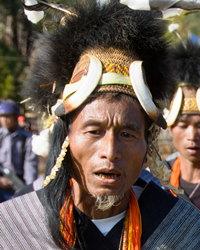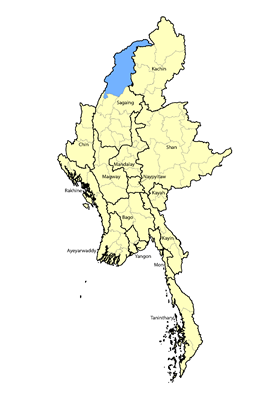Although the people call themselves and their language Kotlum, the members of neighboring tribes use a variety of names for them depending on their dialect, including Kotnu, Kaaolaan, and Ki-paa Nunkan. The Kotlum are one of dozens of small groups in Myanmar who are willing to be identified under the broader Tangshang cultural group, but the various tribes speak their own languages, possess different histories, and have a distinct sense of identity.
Location: With a population estimated at 3,300 people, the little-known Kotlum tribe inhabits villages in Lahe Township in the mountainous Naga Self-Administered Zone, near the border between western Myanmar and the northeast Indian state of Nagaland. Most of the communities where Kotlum people live are mixed with people from other tribes, but four villages with significant Kotlum populations are Pase (60 households), Pungpasu (40), Dewa (38), and Kotlum Nuknan (28).
Language: A team of linguists visited Lahe Township in 2013 and researched 1,162 Kotlum people from 166 households. Although they found that the Kotlum speak their own dialect, which is related to Asen and Raqnu, all Kotlum people were able to speak the language of the Asen, who number only 1,400 people. This connection suggests the Kotlum and Asen may have been one tribe in the past before splintering into different groups today. The linguists also determined that Kotlum shares only a 53 percent lexical similarity with Shecyu, which is considered a premier dialect for Scripture translation among the Tangshang tribes. This low percentage indicates the Kotlum will need their own translation to be able to comprehend the Bible.
The Kotlum people say there used to be a group called the Aaktung who dwelled with them in harmony. One day more than a century ago, however, the two tribes had a bitter dispute that caused the Aaktung to flee south to preserve their lives. The dispute arose after a combined fishing trip when the two tribes came home empty-handed “because the Aaktung people had hidden all the fish somewhere in the jungle. The Kotlum found out about it and they tried to kill all the Aaktung people, but some escaped.”
While the Kotlum people continue to live in their mountainous homeland, harsh living conditions and poor crop yields have caused many Tangshang tribesmen to move to flatter, more arable areas where they mixed with people from other ethnicities in the new village. Because of the climate and terrain, most Tangshang live in stilt houses that contain many rooms, while traditionally each village had separate dormitories for men and women.
For centuries the Kotlum were animists, living in fear of the demonic realm, which had the power to wreak vengeance on them through disease, pestilence, and natural disasters. The 1970s saw an explosion of Christianity in the Lahe area, with most tribes converting to Christ. Today, all Kotlum people identify as Christians, with no vestige of Buddhism or Animism still found in their communities.
Most Christians among Tangshang tribes in Myanmar tend to be affiliated with the Baptists if they were evangelized by Naga tribes from the west, with Catholics if they were influenced by the Kachin to the north, or with the Church of Christ if they were influenced by American missionaries in the past. All Kotlum people in Myanmar today are members of Baptist churches. Because no Scripture has been translated into their language, most Kotlum believers use Burmese Bibles in their meetings, although preaching, praying, announcements, and fellowship is conducted in their more familiar tribal language.
Scripture Prayers for the Kotlum in Myanmar (Burma).
| Profile Source: Asia Harvest |











